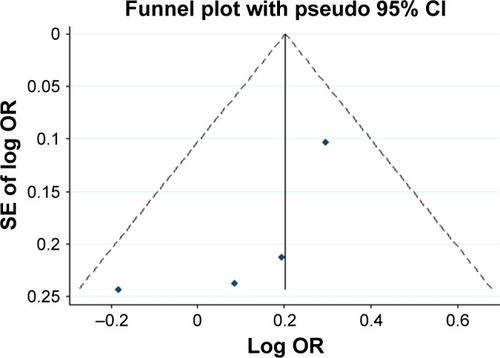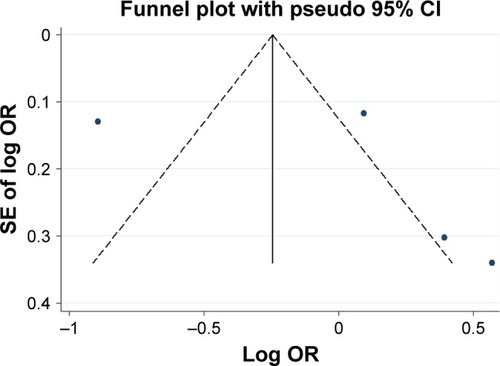Abstract
Background
In order to explore the association between the SLC6A4 gene and the risk of schizophrenia, an updated meta-analysis was conducted using a total of 46 scientific articles.
Methods
Through a literature search, papers studied included 35 articles on serotonin-transporter-linked polymorphic region (5-HTTLPR) with 8,752 cases and 10,610 controls, 17 articles on second intron variable number of tandem repeats with 7,284 cases and 8,544 controls, four studies on rs1042173 with 1,351 cases and 2,101 controls, and four studies on rs140700 with 1,770 cases and 2,386 controls. Pooled, subgroup, and sensitivity analyses were performed, and the results were visualized by forest and funnel plots.
Results
An association between 5-HTTLPR and the risk of schizophrenia was not found, except for an Indian subgroup analysis (Pz=0.014, OR =1.749, 95% CI =1.120–2.731). A 10 repeats/12 repeats (10R/12R) genotype was a protective factor against schizophrenia (Pz=0.020, OR =0.789, 95% CI =0.646–0.963), but a 12R/12R genotype was a risk factor for schizophrenia (Pz=0.004, OR =1.936, 95% CI =1.238–3.029) in the pooled analyses. In Caucasians, a GG genotype of rs1042173 may be a risk factor for schizophrenia (Pz=0.006, OR =1.299, 95% CI =1.079–1.565). No association was found between rs140700 and the risk for schizophrenia.
Conclusion
Through meta-analysis, we were able to gain insight into previously reported associations between SLC6A4 polymorphism and schizophrenia.
Introduction
Schizophrenia is a complex chronic brain dysfunction that has an elusive pathogenesis and is highly heritable.Citation1 Investigations into twins and adoptees have shown that schizophrenia was caused by both genetic and environmental factors.Citation2,Citation3 Epidemiological genetic studies suggested that genetic factors contributed significantly to the etiology of schizophrenia.Citation4 Pathological mechanisms are based on various neurotransmitter and neurodevelopmental hypotheses, and the hypothesis of a 5-hydroxytryptamine (5-HT) system defect is an important one. The serotoninergic pathway has been implicated, for several reasons, as having a major role in the pathophysiology of schizophrenia. By binding with receptors, 5-HT negatively regulates cAMP-dependent signal transduction and inhibits neuronal activity by opening G-protein–gated inwardly rectifying potassium channels.Citation5 The serotonin transporter (5-HTT) has a crucial function in the regulation of 5-HT reuptake in presynaptic neurons. It has been noted that levels of 5-HTT change in schizophrenic patients.Citation6,Citation7 Significant differences in mRNA levels of the serotonin transporter gene (SLC6A4)Citation8 and serotonin transporter protein levelsCitation9 were observed in schizophrenic patients compared with healthy controls. Pharmacological evidence indicated that 5-HTT was a site of action for several drugs with central nervous system effectsCitation10,Citation11 and that 5-HTT was involved in the pathogenesis of schizophrenia.Citation12,Citation13 Therefore, the SLC6A4 gene is a candidate gene for the pathogenesis of schizophrenia.
The most studied polymorphisms in the SLC6A4 gene are a 44-base pair (bp) insertion–deletion (serotonin-transporter-linked polymorphic region [5-HTTLPR]) in the promoter region, generating major L and S alleles, and a 17-bp variable number of tandem repeats (VNTR) in the second intron (STin2).Citation14 The STin2 consists of 17-bp VNTR elements existing in 9, 10, and 12 repeats (9R, 10R, and 12R), although other rare types, such as seven-repeat units, have also been reported. The single-nucleotide polymorphisms (SNPs), rs1042173 and rs140700, are located in the three prime untranslated region and intron 5 of the SLC6A4 gene, respectively. Associations between the SLC6A4 gene and schizophrenia are controversial.Citation15,Citation16 Ambiguous results from different studies may possibly reflect sample sizes insufficient for obtaining adequate statistical power.
A meta-analysis is a useful method for interpreting controversial study results.Citation17,Citation18 Four meta-analyses of the association between the SLC6A4 gene and schizophrenia have been conducted;Citation19–Citation22 however, the results are still controversial. In addition, a meta-analysis of the association between schizophrenia and rs1042173 and rs140700 does not exist. Thus, we intended to perform an updated meta-analysis to better analyze the association of SLC6A4 with schizophrenia.
Materials and methods
Literature searches
To identify studies eligible for inclusion in this meta-analysis, English (PubMed and SchizophreniaGene [SzGene]) and Chinese language (China National Knowledge Infrastructure, Wanfang, and Weipu) databases were searched using the following keywords: “serotonin transporter,” “SERTPR,” “SERT-in2,” “5-HTTLPR,” “STin2 VNTR,” “SLC6A4,” and “schizophrenia.” References of the searched articles were also reviewed to uncover more data.
Inclusion and exclusion criteria
Studies included in the meta-analysis met the following criteria: 1) case–control design; 2) involved patients with schizophrenia; 3) presented relevant data for case and control groups (eg, allele/genotype frequencies, sample size, ethnicity, schizophrenia diagnostic criteria, and control group source); 4) removed duplicate sample data; and 5) published before September 2018. If the article did not contain detailed data, we e-mailed the authors for further information. Studies were excluded for the following reasons: 1) family-based studies; 2) no control group; 3) no usable genotype frequency data (attempts were made to contact authors via e-mail for such data); and 4) duplicate reported sample data.
Statistical analyses
The meta-analysis was conducted using Stata Version 10.0 (Stata Corp., College Station, TX, USA). A P-value of Hardy–Weinberg equilibrium (PHWE) was calculated for control groups. Associations between SLC6A4 and the risk of schizophrenia were detected under the random model.Citation23,Citation24 A suitable genetic model was selected according to the previous articles.Citation25 ORs and 95% CIs were calculated in the pooled and subgroup analyses.
The heterogeneity of studies was determined by using Cochran’s chi-squared Q-statistic test.Citation26 The degree of heterogeneity was expressed as I2,which was divided into low (I2<25%), medium (I2~50%), and high (I2>75%) heterogeneity.Citation27,Citation28 Publication bias was calculated by using Egger’s test and was visualized in a funnel plot, in which the SE of the log OR of each study was plotted against its log OR. Sensitivity analysis, by removing one single study in turn, was conducted to test the impact of each study on pooled results. P-values of association, heterogeneity, and publication bias tests were represented by Pz, Ph, and Pe, respectively. In this study, P<0.05 was regarded as statistically significant in all statistical tests.Citation29 Statistical power was calculated by a PS program (Adobe Systems Incorporated, San Jose, CA, USA).Citation25
Results
Description of studies
A total of 380 English and 16 Chinese published research articles were searched, and 46 articles were analyzed in this study after exclusion according to a PRISMA flow program ().Citation30 Detailed data on five articles could not be obtained after sending e-mails to the authors;Citation31–Citation35 therefore, they were removed in the present meta-analysis. describes the baseline characteristics of 46 studies that were included in this meta-analysis. The studies included 35 articles about 5-HTTLPR,Citation16,Citation36–Citation68 17 studies about Stin2,Citation16,Citation37,Citation39–Citation41,Citation44,Citation47,Citation53,Citation59,Citation65,Citation69–Citation75 four articles about rs1042173,Citation40,Citation47,Citation76,Citation77 and four articles about rs140700.Citation71,Citation76,Citation78,Citation79
Figure 1 Study selection process in this meta-analysis.
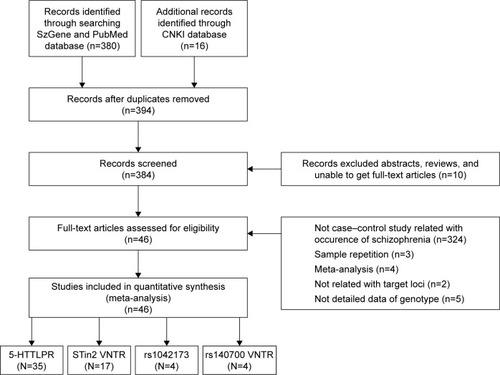
Table 1 Characteristics of the qualified studies in this meta-analysis
No association between 5-HTTLPR and the risk of schizophrenia
In a random model,Citation80,Citation81 the pooled and subgroup analyses of 8,752 cases and 10,610 controls were performed (). summarizes the results of the pooled analyses and depicts the data from the subgroup analyses. No association was found between 5-HTTLPR and the risk of schizophrenia with Pz=0.054 (OR =1.085, 95% CI =0.999–1.178) with a power of 0.935 in the dominant model.Citation82 No associations were found in the subgroup analyses, except in an Indian group (Pz=0.014, OR =1.749, 95% CI =1.120–2.731). No significant heterogeneity was observed in the pooled analysis (Ph=0.294, I2=10.4%).
Table 2 Genotype distribution and allele frequency of 5-HTTLPR
Table 3 Pooled association of SLC6A4 polymorphisms with schizophrenia
Table 4 Subgroup association of SLC6A4 polymorphisms with schizophrenia
Genotypes 10R/12R and 12R/12R of STin2 VNTR may be associated with the risk of schizophrenia
The allele frequencies of 7,284 cases and 8,544 controls were included in the pooled and subgroup analyses, under a random model (); 10R and 12R are common alleles; therefore, alleles (10R and 12R) and genotypes (10R/10R, 10R/12R, and 12R/12R) were analyzed for an association with the risk of schizophrenia, respectively ( and ). A 10R/12R genotype was a protective factor against schizophrenia (Pz=0.020, OR =0.789, 95% CI =0.646–0.963), but a 12R/12R genotype was a risk factor for schizophrenia (Pz=0.004, OR =1.936, 95% CI =1.238–3.029) in the pooled analyses. The two pooled analyses had high powers of 1.000. In the subgroup analyses, 10R/12R was a protective factor against schizophrenia in East Asia (Pz=0.040, OR =0.617, 95% CI =0.389–0.978), India (Pz=0.014, OR =0.635, 95% CI =0.441–0.913) and in a population-based analysis (Pz=0.028, OR =0.794, 95% CI =0.646–0.976). A 12R/12R genotype was a risk factor for schizophrenia in East Asia (Pz=0.000, OR =4.482, 95% CI =2.312–8.689) and in population-based (Pz=0.013, OR =1.755, 95% CI =1.124–2.742) and hospital-based (Pz=0.000, OR =10.689, 95% CI =5.303–21.544) subgroup analyses. The significant heterogeneity was observed in these associated analyses.
Table 5 Genotype distribution and allele frequency of STin2 VNTR
Genotype GG of rs1042173 may be a risk factor for schizophrenia in Caucasians
In a recessive and a random model, no association was detected among 1,351 cases and 2,101 controls (Pz=0.057, OR =1.199, 95% CI =0.994–1.445; ). and shows the results. In Caucasians, a GG genotype may be a risk factor for schizophrenia (Pz=0.006, OR =1.299, 95% CI =1.079–1.565), with a power of 0.893. No significant heterogeneity was observed in the pooled or subgroup analyses.
Table 6 Genotype distribution and allele frequency of rs1042173
No association between rs140700 and the risk of schizophrenia
Under a random model, the allele frequencies of 1,770 cases and 2,386 controls were included in the pooled and subgroup analyses (). In a dominant model, no association was detected between rs140700 and the risk of schizophrenia in the pooled and subgroup analyses ( and ). Significant heterogeneity was observed in the pooled (Ph=0.000, I2=93.2%) and East Asia subgroup (Ph=0.000, I2=93.5%) analyses.
Table 7 Genotype distribution and allele frequency of rs140700
Sensitivity analysis
We conducted sensitivity analyses by omitting each study individually; the pooled ORs did not change significantly. Thus, the results were considered stable and reasonable.
Publication bias
Any publication bias was made visible by funnel plots, in which the SE of the log OR of each study was plotted against its log OR. No evidence of publication bias was found in the pooled analyses (–).
Figure 2 Funnel plot analysis on the detection of publication bias in the association between 5-HTTLPR (SS + LS vs LL) and schizophrenia.
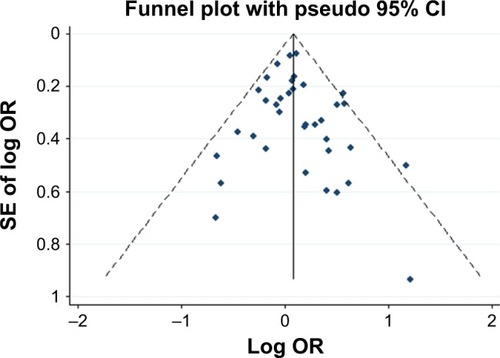
Figure 3 Funnel plot analysis on the detection of publication bias in the association between STin2 VNTR (10R/10R vs others) and schizophrenia.
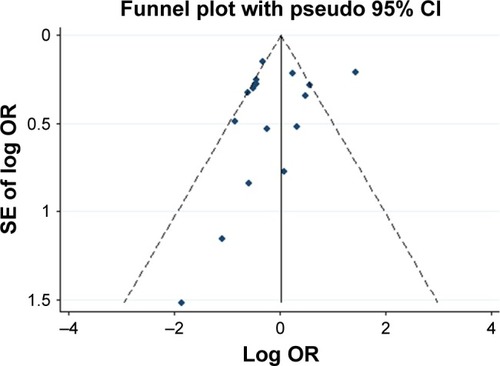
Figure 4 Funnel plot analysis on the detection of publication bias in the association between STin2 VNTR (10R/12R vs others) and schizophrenia.

Figure 5 Funnel plot analysis on the detection of publication bias in the association between STin2 VNTR (12R/12R vs others) and schizophrenia.
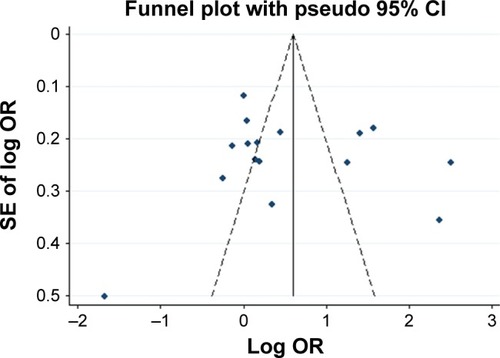
Discussion
We found no association between 5-HTTLPR and the risk of schizophrenia, except in Indians. The scale for Indians was small and was found in only one article; therefore, the association may be a false-positive. A negative association between 5-HTTLPR and the risk of schizophrenia was consistent with the results of the previous meta-analyses,Citation19,Citation21 but inconsistent with the results of Allen et al.Citation22 Differences may exist in results found because Allen et al only analyzed articles on the SzGene in their meta-analysis. An association between suicidal behavior and 5-HTTLPR was not detected in a recent meta-analysis,Citation83 which conflicts with previous evidence suggesting an association between 5-HTTLPR and violent suicidal behavior. The L allele of the 5-HTTLPR was reported as improving transcription of the SLC6A4 gene.Citation84 A meta-analysis noted an association between the S allele of 5-HTTLPR and the risk of bipolar disorder.Citation85 Psychiatric disorders share genetic variants.Citation21 A haplotype, including 5-HTTLPR and rs16965628 markers, is thought to be associated with an obsessive–compulsive disorder.Citation86 Therefore, 5-HTTLPR may link with other SNPs to influence the serotoninergic pathway.
STin2 VNTR was associated with the risk of schizophrenia, but a significant difference was not detected in the allele analysis, inconsistent with other meta-analyses.Citation19,Citation20 Gatt et al reviewed the relevant meta-analysis between STin2 VNTR and schizophrenia and found that the 12R genotype was associated with schizophrenia as a protective factor, while 9R and 10R genotypes were not associated with schizophrenia.Citation21 Our results showed that the 10R/12R genotype was a protective factor for schizophrenia, while the 12R/12R genotype was a risk factor for schizophrenia, in the pooled and several subgroup analyses. Genotypes with 12R may significantly increase relative 5-HTT gene expression,Citation87 leading to increasing vulnerability to schizophrenia. STin2.12R has a superior enhancer-like property within the developing rostral hindbrain, which may lead to aberrant serotonergic neuronal development.Citation40,Citation88 In addition, STin2 acts as a transcriptional regulator in an allele-dependent manner in the developing mouse brain.Citation89 Haplotype analysis demonstrated that two STin2-containing haplotypes were associated with the risk of schizophrenia, but no association was found in the single locus.Citation71 No association was detected in Caucasians and Indians, which may be the result of different genetic backgrounds. Significant heterogeneity was assessed in the pooled analysis, and heterogeneity was found in all subgroups, except Caucasians. This was the first meta-analysis of the association between the risk of schizophrenia and rs1042173 and rs140700.
Gatt et al comprehensively reviewed a meta-analysis of the association between SLC6A4 (5-HTTLPR and STin2 VNTR) and schizophrenia.Citation21 To some extent, it would seem that our meta-analysis is superfluous. However, it was an updated analysis, assessing the association of the SLC6A4 gene with schizophrenia using high statistical powers. Our study also included seven studies published after 2013 and three studies in Chinese. Moreover, four variations (5-HTTLPR, STin2 VNTR, rs1042173, and rs140700) were analyzed in our meta-analysis. Genome-wide association studies (GWASs) can discover novel and unexpected candidate loci in an unbiased manner. Previous GWAS analyses found that the SLC6A4 gene was not associated with schizophrenia.Citation90–Citation93 A comparison of 12 single-disorder GWAS meta-analyses suggested no overlap in significant genetic variants identified from the different studies.Citation21 However, structural magnetic resonance imaging scans suggested that SLC6A4 was related to deficits of brain structural networks in schizophrenia.Citation94 Our results are inconsistent with those of the previous meta-analysis. Several reasons for this may exist: First, many recently published studies were included in our analysis; therefore, the scale of samples used was larger than those used before. Second, the articles from both English and Chinese language databases were included. Third, geographical environment, culture, lifestyle, and genetic background and diseases may affect genetic polymorphisms.Citation95,Citation96
Significant heterogeneity was found in overall and subgroup analyses, especially for STin2 VNTR and rs140700. Although we performed subgroup analyses according to ethnicity to investigate potential sources of heterogeneity, this did not completely account for the heterogeneity. These results suggest that other aspects may partially contribute to heterogeneity, such as distinct genetic backgrounds and the different habits and customs of the people sampled.Citation97
Overall, however, the results described herein should be interpreted with caution. First, the small sample size for rs1042173 and rs140700 should be borne in mind. Several associations only appeared in the subgroup analyses, for which only one or two articles were used. Therefore, these samples may not be representative and comprehensive. In addition, it was hard to conduct subgroup analyses for some SNPs because of so few articles. Second, deviations in the PHWE and significant heterogeneity were observed in this study because of sample bias. Third, family-based studies, which were more robust than case–control designs, were not included in this analysis.Citation98–Citation101 Fourth, interactions between multiple genes and SNPs may affect the risk of schizophrenia,Citation21 meaning that genetic interactional and functional studies are needed.
Conclusion
Our meta-analysis showed a lack of association between 5-HTTLPR and the risk of schizophrenia, except in an Indian subgroup analysis. The 10R/12R genotype was a protective factor against schizophrenia, while the12R/12R genotype was a risk factor for schizophrenia in the pooled analyses. In Caucasians, the GG genotype of rs1042173 may be a risk factor for schizophrenia. No association was found between rs140700 and the risk of schizophrenia. Increased genetic interactional and functional studies are warranted to explore the association between polymorphisms of the SLC6A4 gene and schizophrenia risk.
Disclosure
The authors report no conflicts of interest in this work.
References
- WrayNRVisscherPMNarrowing the boundaries of the genetic architecture of schizophreniaSchizophr Bull2010361142319996148
- SullivanPFThe genetics of schizophreniaPLoS Med200527e21216033310
- UherRGene-environment interactions in severe mental illnessFront Psychiatry2014594824860514
- CardnoAGGottesmanIITwin studies of schizophrenia: from bow-and-arrow concordances to star wars Mx and functional genomicsAm J Med Genet2000971121710813800
- OhnoYNew insight into the therapeutic role of 5-HT1A receptors in central nervous system disordersCent Nerv Syst Agents Med Chem201010214815720518729
- MohammadiARashidiEAmooeianVGBrain, blood, cerebrospinal fluid, and serum biomarkers in schizophreniaPsychiatry Res2018265253829680514
- KimJHKimJHSonYDAltered interregional correlations between serotonin transporter availability and cerebral glucose metabolism in schizophrenia: A high-resolution PET study using [(11)C]DASB and [(18)F]FDGSchizophr Res2017182556527760700
- WatanabeSYNumataSIgaJIGene expression-based biological test for major depressive disorder: an advanced studyNeuropsychiatr Dis Treat20171353554128260899
- BrusovOSFaktorMIZlobinaGPUrovni i molekulyarnyye geterogennost’ belka-perenoschika serotonina v trombotsitakh patsiyentov s razlichnymi psikhicheskimi zabolevaniyami: sravnitel’nyy analiz s ispol’zovaniyem monoklonal’nyye i poliklonal’nyye antitela. [Levels and molecular heterogeneity of serotonin transporter protein in platelets of patients with different mental diseases: a comparative analysis with the use of monoclonal and polyclonal antibodies]Vestn Ross Akad Med Nauk200173742 Russian
- GelernterJPakstisAJKiddKKLinkage mapping of serotonin transporter protein gene SLC6A4 on chromosome 17Hum Genet19959566776807789954
- Health Quality OntarioPharmacogenomic testing for psychotropic medication selection: a systematic review of the Assurex GeneSight Psychotropic TestOnt Health Technol Assess Ser2017174139
- BilicPJukicVVilibicMSavicABozinaNTreatment-resistant schizophrenia and DAT and SERT polymorphismsGene2014543112513224680725
- TerzićTKastelicMDolžanVPlesničarBKInfluence of 5-HT1A and 5-HTTLPR genetic variants on the schizophrenia symptoms and occurrence of treatment-resistant schizophreniaNeuropsychiatr Dis Treat20151145345925759587
- TsaiSJHongCJLiouYJRecent molecular genetic studies and methodological issues in suicide researchProg Neuropsychopharmacol Biol Psychiatry201135480981720977922
- YangBHuangXRuanLNo association of SLC6A3 and SLC6A4 gene polymorphisms with schizophrenia in the Han Chinese populationNeurosc Lett2014579114118
- KaiserRTremblayP-BSchmiderJSerotonin transporter polymorphisms: no association with response to antipsychotic treatment, but associations with the schizoparanoid and residual subtypes of schizophreniaMolecular Psychiatry20016217918511317220
- KebedeMMZeebHPetersMHeiseTLPischkeCREffectiveness of Digital Interventions for Improving Glycemic Control in Persons with Poorly Controlled Type 2 Diabetes: A Systematic Review, Meta-analysis, and Meta-regression AnalysisDiabetes Technol Ther2018201176778230257102
- LeeJThe Relationship Between Physical Activity and Dementia: A Systematic Review and Meta-Analysis of Prospective Cohort StudiesJ Gerontol Nurs20184410222930257021
- FanJBSklarPMeta-analysis reveals association between serotonin transporter gene STin2 VNTR polymorphism and schizophreniaMol Psychiatry2005101092893815940296
- ShiJGershonESLiuCGenetic associations with schizophrenia: meta-analyses of 12 candidate genesSchizophr Res20081041–39610718715757
- GattJMBurtonKLWilliamsLMSchofieldPRSpecific and common genes implicated across major mental disorders: a review of meta-analysis studiesJ Psychiatr Res20156011325287955
- AllenNCBagadeSMcQueenMBSystematic meta-analyses and field synopsis of genetic association studies in schizophrenia: the SzGene databaseNat Genet200840782783418583979
- MunafòMRFlintJMeta-analysis of genetic association studiesTrends Genet200420943944415313553
- MyungSKParkJYThe Korean Meta-Analysis (KORMA) Study GroupEfficacy of pharmacotherapy for smoking cessation in adolescent smokers: a meta-analysis of randomized controlled trialsNicotine Tob Res Epub2018818
- XuFLWuXZhangJJWangBJYaoJA meta-analysis of data associating DRD4 gene polymorphisms with schizophreniaNeuropsychiatr Dis Treat20181415316429379288
- ZintzarasEIoannidisJPHeterogeneity testing in meta-analysis of genome searchesGenet Epidemiol200528212313715593093
- HigginsJPThompsonSGDeeksJJAltmanDGMeasuring inconsistency in meta-analysesBMJ2003327741455756012958120
- NaingCReidSAAungKComparing antibiotic treatment for leptospirosis using network meta-analysis: a tutorialBMC Infect Dis20171712928056834
- SedgwickPMarstonLHow to read a funnel plot in a meta-analysisBMJ2015351h471826377337
- MoherDLiberatiATetzlaffJAltmanDGPRISMA GroupPreferred reporting items for systematic reviews and meta-analyses: the PRISMA statementPLoS Med200967e100009719621072
- KonnekerTICrowleyJJQuackenbushCRNo association of the serotonin transporter polymorphisms 5-HTTLPR and RS25531 with schizophrenia or neurocognitionAm J Med Genet B Neuropsychiatr Genet2010153B51115111720468059
- LinHLeiYZhangBDaiZLuXCommon variants of HTR1A and SLC6A4 confer the increasing risk of Schizophrenia susceptibility: A population-based association and epistasis analysisAm J Med Genet Part B Neuropsychiatr Genet20151688749755
- ChotaiJSerrettiALattuadaELorenziCLilliRGene-environment interaction in psychiatric disorders as indicated by season of birth variations in tryptophan hydroxylase (TPH), serotonin transporter (5-HTTLPR) and dopamine receptor (DRD4) gene polymorphismsPsychiatry Res20031191–29911112860364
- FrischAFinkelBMichaelovskyESigalMLaorNWeizmanRA rare short allele of the serotonin transporter promoter region (5-HTTLPR) found in an aggressive schizophrenic patient of Jewish Libyan originPsychiatr Genet200010417918311324943
- DuttAMcDonaldCDempsterEThe effect of COMT, BDNF, 5-HTT, NRG1 and DTNBP1 genes on hippocampal and lateral ventricular volume in psychosisPsychol Med200939111783179719573260
- PaeCUArtioliPSerrettiANo evidence for interaction between 5-HT2A receptor and serotonin transporter genes in schizophreniaNeurosci Res200552219519915893580
- SáizPAGarcía-PortillaMPArangoCAssociation study of serotonin 2A receptor (5-HT2A) and serotonin transporter (5-HTT) gene polymorphisms with schizophreniaProg Neuropsychopharmacol Biol Psychiatry200731374174517291660
- NaylorLDeanBPereiraAMackinnonAKouzmenkoACopolovDNo association between the serotonin transporter-linked promoter region polymorphism and either schizophrenia or density of the serotonin transporter in human hippocampusMol Med19984106716749848084
- IkedaMIwataNSuzukiTNo association of serotonin transporter gene (SLC6A4) with schizophrenia and bipolar disorder in Japanese patients: association analysis based on linkage disequilibriumJ Neural Transm2006113789990516082508
- VijayanNNIwayamaYKoshyLVEvidence of association of serotonin transporter gene polymorphisms with schizophrenia in a South Indian populationJ Hum Genet200954953854219713975
- LeeHYKimDJLeeHJChoiJEKimYKNo association of serotonin transporter polymorphism (5-HTTVNTR and 5-HTTLPR) with characteristics and treatment response to atypical antipsychotic agents in schizophrenic patientsProg Neuropsychopharmacol Biol Psychiatry200933227628019059448
- PaeCUKimJJLeeSJPolymorphism of the serotonin transporter gene and symptomatic dimensions of schizophrenia in the Korean populationNeuropsychobiology200347418218612824740
- GuHLiuCLiuCThe combined effects of the 5- HTTLPR and HTR1A rs6295 polymorphisms modulate decision making in schizophrenia patientsGenes Brain Behav201312113313923036158
- HerkenHErdalMEBökeOSavaşHABökeÖmerSavasHATardive dyskinesia is not associated with the polymorphisms of 5-HT2A receptor gene, serotonin transporter gene and catechol-o-methyltransferase geneEur Psychiatry2003182778112711403
- SerrettiALilliRLorenziCLattuadaECusinCSmeraldiESerotonin transporter gene (5-HTTLPR) and major psychosesMol Psychiatry200271959911803453
- HanDHParkDBNaCKeeBSLeeYSAssociation of aggressive behavior in Korean male schizophrenic patients with polymorphisms in the serotonin transporter promoter and catecholamine-O-methyltransferase genesPsychiatry Res20041291293715572182
- ZaboliGJönssonEGGizatullinRDe FranciscisAÅsbergMLeopardiRHaplotype analysis confirms association of the serotonin transporter (5-HTT) gene with schizophrenia but not with major depressionAm J Med Genet Part B Neuropsychiatr Genet2008147B3301307
- GolimbetVKorovaitsevaGLezheikoTAbramovaLIKaledaVGThe serotonin transporter gene 5-HTTLPR polymorphism is associated with affective psychoses but not with schizophrenia: A large-scale study in the Russian populationJ Affect Disord201720860460928029428
- PeitlVŠtefanovićMKarlovićDDepressive symptoms in schizophrenia and dopamine and serotonin gene polymorphismsProg Neuropsychopharmacol Biol Psychiatry20177720921528416295
- TeaTMatejKVitaDKoresPBInfluence of 5-HT1A and 5-HTTLPR genetic variants on the schizophrenia symptoms and occurrence of treatment-resistant schizophreniaNeuropsychiatr Dis Treat20151145345925759587
- GolimbetVEKorovaitsevaGIFaktorMIGanishevaTKDmitrievDAFunktsional’nyy faktor serotoninergicheskoy sistemy i polimorfizm 5-HTTLPR gena serotoninovogo transportera u bol’nykh shizofreniyey [Functional siate of serotoninergic system and the 5-HTTLPR polymorphism of the serotonin transporter gene in patients with schizophrenia]Mol Biol2010442251256
- GolimbetVEAlfimovaMVShcherbatikhTKaledaVGAbramovaLIRogaevEISerotonin transporter gene polymorphism and schizoid personality traits in the patients with psychosis and psychiatrically well subjectsWorld J Biol Psychiatry200341252912582974
- StöberGJatzkeSHeilsASusceptibility for schizophrenia is not influenced by a functional insertion/deletion variant in the promoter of the serotonin transporter geneEur Arch Psychiatry Clin Neurosci1998248282869684917
- KotlerMBarakPCohenHHomicidal behavior in schizophrenia associated with a genetic polymorphism determining low catechol O-methyltransferase (COMT) activityAm J Med Genet199988662863310581481
- RaoDJönssonEGPausSGanguliRNöthenMNimgaonkarVLSchizophrenia and the serotonin transporter genePsychiatr Genet1998842072129861638
- PakhomovaSAKorovaĭtsevaGIMiuMMolekulyarno-geneticheskiy izucheniye ranney shizofrenii [Molecular-genetic study of early-onset schizophrenia]Zh Nevrol Psikhiatr Im S Korsakova201011026669 Russian
- Mendes de OliveiraJROttoPAValladaHAnalysis of a novel functional polymorphism within the promoter region of the serotonin transporter gene (5-HTT) in Brazilian patients affected by bipolar disorder and schizophreniaAm J Med Genet19988132252279603609
- BayleFJLeroySGourionD5HTTLPR polymorphism in schizophrenic patients: Further support for association with violent suicide attemptsAm J Med Genet Part B Neuropsychiatr Genet2003119B11317
- MataIArranzMJPatiñoASerotonergic polymorphisms and psychotic disorders in populations from North SpainAm J Med Genet Part B Neuropsychiat Genet2004126B18894
- SanjuanJRiveroOAguilarEJSerotonin transporter gene polymorphism (5-HTTLPR) and emotional response to auditory hallucinations in schizophreniaInt J Neuropsychopharmacol20069113113315916716
- ChongSALeeWLTanCHTayAHChanAOTanECAttempted suicide and polymorphism of the serotonin transporter gene in Chinese patients with schizophreniaPsychiatry Res2000972–310110611166082
- PaeCUSerrettiAArtioliPInteraction analysis between 5-HTTLPR and TNFA -238/-308 polymorphisms in schizophreniaJ Neural Transm2006113788789716252073
- YoungKAHolcombLABonkaleWLHicksPBYazdaniUGermanDC5HTTLPR polymorphism and enlargement of the pulvinar: unlocking the backdoor to the limbic systemBiol Psychiatry200761681381817083920
- Jing XuxiuZRKerunGShibangSStudy on the correlation between the polymorphism in promoter region of 5-hydroxytryptamine transporter gene and schizophrenia in Chinese Han populationJ Shanghai Jiaotong Univ20163645
- LiZMLiWA study of correlation between serotonin transporter gene polymorphism and schizophreniaJ Clin Psychiatry20132364
- Zuo SueWXGuiqingCYichangCYongSAnalysis of the correlation between 5-H T T L P R and mental splitting attack behaviorChin J Forensic Med20131822
- TsaiSJHongCJYuYWAssociation study of a functional serotonin transporter gene polymorphism with schizophrenia, psychopathology and clozapine responseSchizophr Res200044317718110962219
- LuATBakkerSJansonECichonSCantorRMOphoffRAPrediction of serotonin transporter promoter polymorphism genotypes from single nucleotide polymorphism arrays using machine learning methodsPsychiatr Genet201222418218822504458
- Bonnet-BrilhaultFLaurentCThibautFSerotonin transporter gene polymorphism and schizophrenia: an association studyBiol Psychiatry19974276346369376461
- LiuWGuNFengGTentative association of the serotonin transporter with schizophrenia and unipolar depression but not with bipolar disorder in Han ChinesePharmacogenetics19999449149510780268
- LinCTangWHuJHaplotype analysis confirms association of the serotonin transporter (5-HTT) gene with schizophrenia in the Han Chinese populationNeurosci Lett2009453321021319429037
- TsaiSJOuyangWCHongCJAssociation for serotonin transporter gene variable number tandem repeat polymorphism and schizophrenic disordersNeuropsychobiology200245313113311979062
- HerkenHErdalMEAynacioğluASFrequency of the 17-bp variable number of tandem repeat polymorphism in Turkish schizophrenic patientsSchizophr Res20025819910012363397
- CollierDAArranzMJShamPThe serotonin transporter is a potential susceptibility factor for bipolar affective disorderNeuroreport1996710167516798904780
- YangSCorrelation analysis between SERT gene and schizophrenia and analysis of its single nucleotide polymorphism [master’s thesis]KirklandNorthwest University2001 Chinese
- Lindholm CarlströmESaetrePRosengrenAAssociation between a genetic variant in the serotonin transporter gene (SLC6A4) and suicidal behavior in patients with schizophreniaBehav Brain Funct2012812422594806
- XuanJFDingMPangHRelationship between genetic polymorphisms of 3 SNP loci in 5-HTT gene and paranoid schizophreniaFa Yi Xue Za Zhi2012286418421 Chinese23484320
- LiWYangYLinJAssociation of serotonin transporter gene (SLC6A4) polymorphisms with schizophrenia susceptibility and symptoms in a Chinese-Han populationProg Neuropsychopharmacol Biol Psychiatry20134429029523583772
- PalPMihanovićMMolnarSAssociation of tagging single nucleotide polymorphisms on 8 candidate genes in dopaminergic pathway with schizophrenia in Croatian populationCroatian Med J2009504361369
- QiXLXuanJFXingJXWangBJYaoJNo association between dopamine D3 receptor gene Ser9Gly polymorphism (rs6280) and risk of schizophrenia: an updated meta-analysisNeuropsychiatr Dis Treat2017132855286529200860
- PalmerSCGardnerSTonelliMPhosphate-Binding Agents in Adults With CKD: A Network Meta-analysis of Randomized TrialsAm J Kidney Dis201668569170227461851
- ThakkinstianAMcElduffPD’EsteCDuffyDAttiaJA method for meta-analysis of molecular association studiesStat Med20052491291130615568190
- FanelliGSerrettiAThe influence of the serotonin transporter gene 5-HTTLPR polymorphism on suicidal behaviors: a meta-analysisProg Neuropsychopharmacol Biol Psychiatry20198837538730125622
- HuXZLipskyRHZhuGSerotonin transporter promoter gain-of-function genotypes are linked to obsessive-compulsive disorderAm J Hum Genet200678581582616642437
- RaoSHanXShiMAssociations of the serotonin transporter promoter polymorphism (5-HTTLPR) with bipolar disorder and treatment response: A systematic review and meta-analysisProg Neuropsychopharmacol Biol Psychiatry20198921422630217771
- WendlandJRMoyaPRKruseMRA novel, putative gain-of-function haplotype at SLC6A4 associates with obsessive-compulsive disorderHum Mol Genet200817571772318055562
- HranilovicDStefuljJSchwabSSerotonin transporter promoter and intron 2 polymorphisms: relationship between allelic variants and gene expressionBiol Psychiatry200455111090109415158428
- LovejoyEAScottACFiskerstrandCEBubbVJQuinnJPThe serotonin transporter intronic VNTR enhancer correlated with a predisposition to affective disorders has distinct regulatory elements within the domain based on the primary DNA sequence of the repeat unitEur J Neurosci200317241742012542679
- FiskerstrandCELovejoyEAQuinnJPAn intronic polymorphic domain often associated with susceptibility to affective disorders has allele dependent differential enhancer activity in embryonic stem cellsFEBS Lett1999458217117410481059
- WangKSLiuXFAragamNA genome-wide meta-analysis identifies novel loci associated with schizophrenia and bipolar disorderSchizophr Res20101241–319219920889312
- ZhaoYLiangXZhuFA large-scale integrative analysis of GWAS and common meQTLs across whole life course identifies genes, pathways and tissue/cell types for three major psychiatric disordersNeurosci Biobehav Rev20189534735230339835
- IkedaMTakahashiAKamataniYGenome-Wide Association Study Detected Novel Susceptibility Genes for Schizophrenia and Shared Trans-Populations/Diseases Genetic EffectSchizophrenia Bulletin2018511
- YinLCheungEFChenRYWongEHShamPCSoHCLeveraging genome-wide association and clinical data in revealing schizophrenia subgroupsJ Psychiatr Res201810610611730312963
- JagannathanKCalhounVDGelernterJGenetic associations of brain structural networks in schizophrenia: a preliminary studyBiol Psychiatry201068765766620691427
- FreySThe economic burden of schizophrenia in Germany: a population-based retrospective cohort study using genetic matchingEur Psychiatry201429847948924853296
- WaltonELiuJHassJMB-COMT promoter DNA methylation is associated with working-memory processing in schizophrenia patients and healthy controlsEpigenetics2014981101110724837210
- YaoJPanYQDingMPangHWangBJAssociation between DRD2 (rs1799732 and rs1801028) and ANKK1 (rs1800497) polymorphisms and schizophrenia: a meta-analysisAm J Med Genet B Neuropsychiatr Genet2015168B111325504812
- CorreaHCampi-AzevedoACde MarcoLFamilial suicide behaviour: association with probands suicide attempt characteristics and 5-HTTLPR polymorphismActa Psychiatr Scand2004110645946415521831
- SemwalPPrasadSBhatiaTFamily-based association studies of monoaminergic gene polymorphisms among North Indians with schizophreniaMol Psychiatry20016222022411317226
- DubertretCHanounNAdèsJHamonMGorwoodPFamily-based association study of the 5-HT transporter gene and schizophreniaInt J Neuropsychopharmacol1999818792
- DimitrovaAGeorgievaLNikolovIMajor psychiatric disorders and the serotonin transporter gene (SLC6A4): family-based association studiesPsychiatr Genet200212313714112218657


